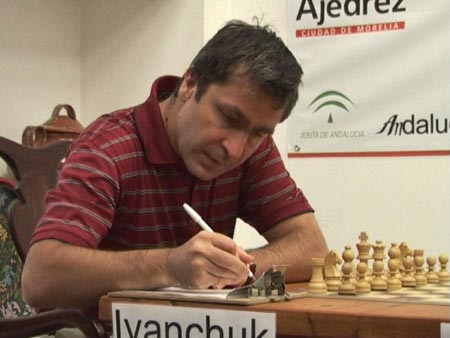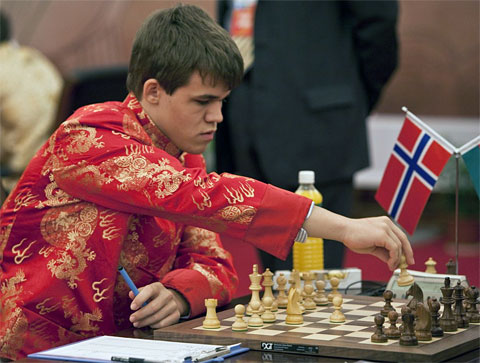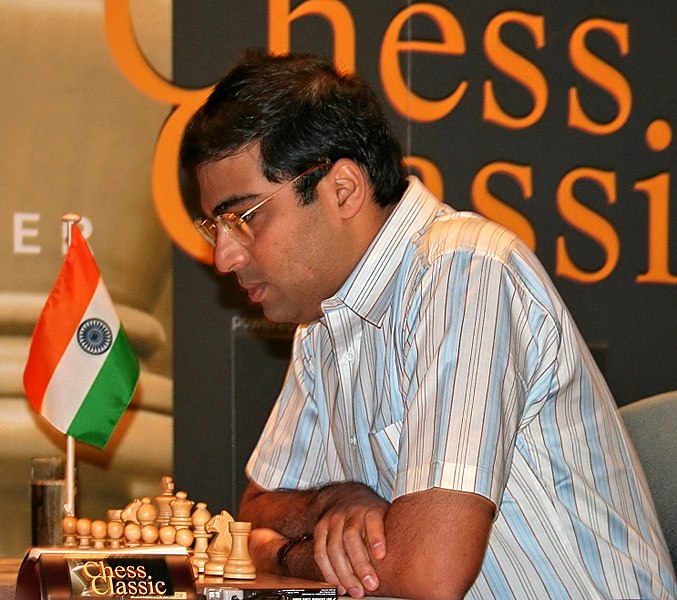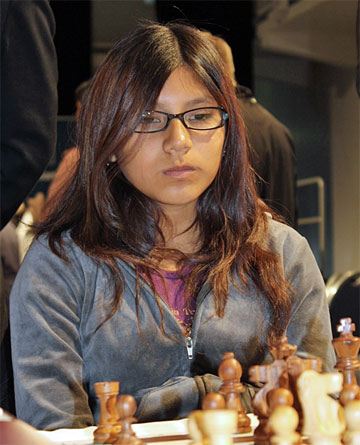| Latest | Greatest | Lobby | Journals | Search | Options | Help | Login |
|
|
|
This topic is archived. |
| Home » Discuss » Topic Forums » Sports |
|
| Jack Rabbit
|
Sun Nov-15-09 04:45 PM Original message |
| The JR Chess Report (November 15): Kramnik wins the Tal; Magnus new numero uno |
|
Edited on Sun Nov-15-09 05:06 PM by Jack Rabbit
Kramnik Wins Tal Memorial; Magnus Takes over as Numero Uno
 Former world champion Vladimir Kramnik of Russia won the Tal Memorial Tournament for 2009 in Moscow 6 points in nine rounds, a half point ahead of Norwegian teenager Magnus Carlsen and 40-year-old Ukrainian GM Vassily Ivanchuk. Vladimir Borisovich won three games, more than any other player in the tournament, without a loss. Magnus and Ivanchuk scored 2 wins each without a loss. Reigning world champion Vishy Anand of India, who was chasing Kramnik for most of the tournament, lost to Armenia's Levon in the final round to finish tied for fourth with Aronian with two wins and one loss each. Magnus, now training under former world champion Garry Kasparov, was the pre-event favorite following his spectacular performance at the Nanjing Grand Prix a month ago, caught a fever in the early rounds and was taking antibiotics. He may have been a little off his game, drawing each of his games in the first seven rounds. However, Magnus recovered his game if not his health and defeated Ukrainian GM Ruslan Ponomariov in the eighth round and then scored a Black vicotry over Hungary's Peter Leko in the ninth and final round. Magnus' two late-round wins were not only enough to put him in second place, but enough to overtake former FIDE world champion Veselin Topalov by a half point as the world's unofficial highest rated player. Topalov will be officially number one at least until January 1 when the new ratings come out from FIDE, but the leading unofficial rating tracking website run by Hans Arlid Runde shows Magnus currently 0.6 points ahead of Topalov. [br />Magnus, who turns 19 on November 30, making him the youngest numero uno ever. Mikhail Tal (1936-1992) was world champion in 1960-61 and was one of the most popular chess players of all time. Tal was famous for his risky play, which served him extremely well. A man of great wit, he answered his critics by quipping, "There are two kinds of sacrifices: sound ones and mine." Afflicted by kidney disease from childhood, Tal also felt he had nothing to lose by taking risks with his health. When asked for his opinion on postal chess, Tal said, "I drink, I smoke, I gamble and I chase girls; but postal chess is a vice I've never acquired." Tal died in a Moscow hospital at age 55. The cause of death was given as kidney failure, but a friend said that, in fact, all his vital organs gave out at once. 2009 World Youth Chess Championship Begins in Turkey  From the official website of the 2009 World Youth Chess Championship The annual World Youth Chess Championship, featuring 2000 players from under 10 to eighteen years old, got under way Thursday in Antalya, Turkey. Unlike the just completed World Junior Championships, which were held last month in Puerto Madryn, Argentina, the World Youth event is grouped into age categories as well as by gender. This arrangment makes the World Youth event less elite, a fact also compounded with the World Junior event being open to players under 21. However, the the players group by age, the World Youth event attracts younger players than any who participate in the World Junior. The official website was having some problems this morning (fortunatly, nothing like the problems the World Junior Championship website had recently), but your humble hare can now report that after today's fourth round Turkish IM Mustafa Yilmaz and Russian FM Nikolay Shukh lead the Boys' 17- and 18=year-old group with perfect scores, while in the same age group for Girls, two untitled players, Anastasia Savina of Russia and Monika Motycakova of Slovakia, are tied for first with Russian WFM Victoria Korchagina with perfect scores. Peruvian WIM Deysi Cori Tello, who just distinguished herself by finishing a very close second in Puerto Madyn, is also competing in the World Youth in the 15- and 16-year-old Girls' Group. She is tied for first in that group with a perfect score through four rounds. La se�orita Cori impressed observers in Puerto Madryn with her sharp, tactical play. The World Youth Chess Championship runs through November 22. Calendar World Cup, Khanty Mansiysk 28 November-15 December. London Chess Classic 7-16 December. Adams, Carlsen, Howell, Kramnik, McShane, Nakamura, Ni Hua and Short. European Union Championship, Alicante (Spain) 9-20 December. Hastings Chess Congress 26 December 2009-5 January 2010. Rilton Cup, Stockholm 27 December 2009-5 January 2010. Corus Chess Tournament, Wijk aan Zee 15-31 January 2010. Group A: Anand, Carlsen, Caruana, Dominguez, Ivanchuk, Karjakin, Kramnik, Leko, Nakamura, Shirov, Short, Smmets, Tiviakov and van Wely. Gibraltar Chess Festival 26 January-4 February. European Individual Championships, Rijeka (Croatia) 5-19 March. Anand-Topalov Match for the World Title, Sofia Tentatively 5-24 April (will be finalized after consulting players). |
| Printer Friendly | Permalink | | Top |
| Jack Rabbit
|
Sun Nov-15-09 04:46 PM Response to Original message |
| 1. This week's games |
|
Your humble hare acknowledges the assistance of Fritz 6.0 on analysis. Diagrams on the Jack Rabbit Chess Report are made with Chess M�rida, a true type font that can be downlaoded free here. !""""""""# $tMvWlVmT% $OoOoOoOo% $ + + + +% $+ + + + % $ + + + +% $+ + + + % $pPpPpPpP% $RnBqKbNr% /(((((((() WHITE White to move (This position is a theoretical draw) I would like to thank my impressive and loyal staff: Buccaneer, Spitfire, Swashbuckler, Pancho and Robin Hood |
| Printer Friendly | Permalink | | Top |
| Jack Rabbit
|
Sun Nov-15-09 04:48 PM Response to Reply #1 |
| 2. Tal Memorial Tournament, Moscow |
| Printer Friendly | Permalink | | Top |
| Jack Rabbit
|
Sun Nov-15-09 04:54 PM Response to Reply #2 |
| 5. Morozevich - Kramnik, Round 3 |
 Vladimir Kramnik Alexander Morozevish - Vladimir Kramnik Tal Memorial Tournament, Round 3 Moscow, 7 November 2009 East India Gambe: Nimzo-Indian Defense (Capablanca Opening) 1.d4 Nf6 2.c4 e6 3.Nc3 Bb4 4.Qc2 0-0
5.a3 Bxc3+ 6.Qxc3 d5
7.Nf3
7...dxc4 8.Qxc4 b6 9.Bf4
9...Ba6 10.Qc2
10...Nbd7 11.e4 Bxf1 12.Kxf1!?
12...c5
13.Bd6 Re8 14.e5 Nd5 !""""""""# $t+ Wt+l+% $O +m+oOo% $ O Bo+ +% $+ OmP + % $ + P + +% $P + +n+ % $ Pq+ PpP% $R + +k+r% /(((((((() WHITE: Alexander Morozevich Position after 14...Nf6d5 15.h4!?
15...cxd4 16.Ng5 f5!?
17.Qc4
17...Qc8 18.Qxd4 Nc5 19.Rd1!?
19...Nb3!
20.Qd3 Nc1 21.Qb5?!
!""""""""# $t+w+t+l+% $O + + Oo% $ O Bo+ +% $+q+mPoN % $ + + + P% $P + + + % $ P + Pp+% $+ Mr+l+r% /(((((((() WHITE: Alexander Morozevich Position after 21.Qd3b5 21...Qc2!
22.Rxd5
22...a6!
23.Qxb6
23...Qc4+ 24.Kg1 exd5
25.g3 h6
26.Nf3 f4
27.g4 Qe4 28.Kg2 Nd3 29.Qb3 Qc4 30.Qb7?
!""""""""# $t+ +t+l+% $+q+ + O % $o+ B + O% $+ +oP + % $ +w+ OpP% $P +m+n+ % $ P + Pk+% $+ + + +r% /(((((((() WHITE: Alexander Morozevich Position after 30.Qb3b7 30...Nxf2!!
31.Kxf2 Qc2+ 32.Kg1 Qd1+ 33.Kf2
33...Qxh1 34.e6 Rac8 35.Qf7+
35...Kh8 36.Bc5 Qc1 37.b4 Qc2+
38.Kg1 Qe2 39.Nd4 Qxg4+ 40.Kf2
40...Qxh4+ 41.Ke2 f3+ 42.Kxf3
42...Rf8 43.Bxf8
!""""""""# $ +t+ B L% $+ + +qO % $o+ +p+ O% $+ +o+ + % $ P N + W% $P + +k+ % $ + + + +% $+ + + + % /(((((((() WHITE: Alexander Morozevich Position after 43.Bc5f8:R 43...Rc3+!!
44.Kg2 Qg3+ 45.Kf1 Rc1+ 0-1
|
| Printer Friendly | Permalink | | Top |
| Jack Rabbit
|
Sun Nov-15-09 04:56 PM Response to Reply #2 |
| 6. Ivanchuk - Gelfand, Round 7 |
 Vassily Ivanchuk Vassily Ivanchuk - Boris Gelfand Tal Memorial Tournament, Round 7 Moscow, 12 November 2009 Slav Queen's Gambit: Tikhi Opening 1.d4 d5 2.c4 c6 3.Nf3 Nf6 4.e3 Bg4
5.h3 Bxf3
6.Qxf3 e6 7.Nc3 Nbd7 8.Bd3 dxc4!?
9.Bxc4
9...Bd6 10.0-0 0-0 11.e4 e5 12.d5 Nb6!?
13.Bd3!
13...cxd5 14.exd5 h6
15.Be3 Rc8 16.Rac1 Nc4
17.Bxc4 Rxc4 18.Qe2
18...Rc8 !""""""""# $ +tW Tl+% $Oo+ +oO % $ + B M O% $+ +pO + % $ + + + +% $+ N B +p% $pP +qPp+% $+ R +rK % /(((((((() WHITE: Vassily Ivanchuk Position after 18...Rc4c8 19.Bxa7
19...b6!
20.Nb5!
20...Rc5 21.Rfd1 Qd7 22.Nxd6 Qxd6
23.Rxc5 Qxc5 24.Qe3 Qc2 25.Qb3!
25...Qxb3 26.axb3 Rd8 27.d6
27...b5!?
!""""""""# $ + R +l+% $B + +oO % $ + P M O% $+o+ O + % $ + + + +% $+p+ + +p% $ P + Pp+% $+ +r+ K % /(((((((() WHITE: Vassily Ivanchuk Position after 27...b6b5 28.f3!
28...Ra8
29.Be3 Nd7 30.Rd5 Rb8 31.f4 exf4 32.Bxf4 f6 33.Rd2
33...Kf7 34.Kf2 Ke6 35.Ke3 Rc8!?
!""""""""# $ +t+ + +% $+ +m+ O % $ + PlO O% $+o+ + + % $ + + B +% $+p+ K +p% $ P R +p+% $+ + + + % /(((((((() WHITE: Vassily Ivanchuk Position after 35...Rb8c8 36.Kd4!
36...g5?
37.Re2+!
37...Ne5 38.Bxe5 fxe5+ 39.Rxe5+ Kxd6 40.Rxb5
40...Rc2 41.g4 Rxb2 42.Rb6+ Kc7 43.Kc3!! 1-0 !""""""""# $ + + + +% $+ L + + % $ R + + O% $+ + + O % $ + + +p+% $+pK + +p% $ T + + +% $+ + + + % /(((((((() WHITE: Vassily Ivanchuk Final Position after 43.Kd4c3
|
| Printer Friendly | Permalink | | Top |
| Jack Rabbit
|
Sun Nov-15-09 04:57 PM Response to Reply #2 |
| 7. Carlsen - Ponomariov, Round 8 |
 Magnus Carlsen Magnus Carlsen - Ruslan Ponomariov Tal Memorial Tournament, Round 8 Moscow, 13 November 2009 Open Sicilian Game: Najdorf-Scheveningen Defense (Chandler-Nunn Opening) 1.e4 c5 2.Nf3 d6 3.d4 cxd4 4.Nxd4 Nf6 5.Nc3 a6 6.Be3 e6 7.f3
7...b5
8.Qd2 Nbd7 9.g4 h6 10.0-0-0 Ne5
11.Qe1!?
11...Qc7
12.h4 b4
13.Nce2 Nc4!?
14.Nf4
14...Nxe3 15.Qxe3 Qb6
16.Bc4 Qc5 17.Qb3 d5
18.exd5 Bd6 19.Nfxe6 fxe6 20.dxe6 Be7
21.Qd3
21...0-0 22.Bb3
22...Rd8?
!""""""""# $t+vT +l+% $+ + V O % $o+ +pM O% $+ W + + % $ O N +pP% $+b+q+p+ % $pPp+ + +% $+ Kr+ +r% /(((((((() WHITE: Magnus Carlsen Position after 22...Rf8d8 23.g5!
23...Nh7
24.gxh6 Qh5 25.Qe4 Qxh6+
26.Kb1 Ra7
27.Nf5 Rxd1+ 28.Rxd1 Qf6
!""""""""# $ +v+ +l+% $T + V Om% $o+ +pW +% $+ + +n+ % $ O +q+ +% $+b+ + + % $pPp+ + +% $+k+r+ + % /(((((((() WHITE: Magnus Carlsen Position after 28...Qh6f6 29.Rd7!!
29...Bxd7 30.exd7+ Kf8 31.Qd5 1-0
|
| Printer Friendly | Permalink | | Top |
| Jack Rabbit
|
Sun Nov-15-09 04:59 PM Response to Reply #2 |
| 8. Anand - Leko, Round 5 |
 Vishy Anand Vishy Anand - Peter Leko Tal Memorial Tournament, Round 5 Moscow, 10 November 2009 Semi-Slav Queen's Gambit: Grand Anti-Meran Gambit 1.d4 d5 2.c4 c6 3.Nf3 Nf6 4.Nc3 e6 5.Bg5 h6 6.Bh4
6...dxc4 7.e4 g5 8.Bg3 b5
9.Be2
9...Bb7 10.0-0
10...Nbd7 11.Ne5 Bg7
12.Nxd7 Nxd7 13.Bd6 a6 14.a4
14...e5 15.Bg4
15...exd4 16.e5 c5 17.Re1
17...Nxe5!? 18.Bxe5 0-0 19.Bxg7 Kxg7 20.Ne2 f5 21.Bh5 f4 22.Nxd4!?
22...cxd4
23.Re6
23...Bc8?!
!""""""""# $t+vW T +% $+ + + L % $o+ +r+ O% $+o+ + Ob% $p+oO O +% $+ + + + % $ P + PpP% $R +q+ K % /(((((((() WHITE: Vishy Anand Position after 23...Bb7c8 24.Rg6+!
24...Kh7 25.axb5!
25...Rf6
26.Rxf6 Qxf6 27.Qc2+ Bf5 28.Qxc4!
28...Rc8 29.Qd5 axb5 !""""""""# $ + + + +% $+ + + +l% $ + + W O% $+o+q+vOb% $ + P O +% $+ + + + % $ P + PpP% $R + + K % /(((((((() WHITE: Vishy Anand Position after 29...ab5:p 30.h3!
30...Kh8 31.Qxb5
31...Rf8 32.Ra6 Qg7 33.Rd6 d3 34.Qb6
34...Qe5?
!""""""""# $ + + T L% $+ + + + % $ Q R + O% $+ + WvOb% $ + + O +% $+ +o+ +p% $ P + Pp+% $+ + + K % /(((((((() WHITE: Vishy Anand Position after 34...Qg7e5 35.Bg6!
35...d2 36.Bxf5 Qxf5 37.Qd4+ Kh7 38.Qxd2
38...Rf7 39.f3 h5 40.Rd5 Qg6
41.Qa5 Rg7 42.h4 Qb1+ 43.Kh2 Qxb2 44.Rxg5 Rxg5 45.Qxg5 1-0 !""""""""# $ + + + +% $+ + + +1% $ + + + +% $+ + + Wo% $ + + O P% $+ + +p+ % $ W + +pK% $+ + + + % /(((((((() WHITE: Vishy Anand Final Position after 45.Qa5g5:R
|
| Printer Friendly | Permalink | | Top |
| Jack Rabbit
|
Sun Nov-15-09 04:49 PM Response to Reply #1 |
| 3. World Junior Champioships, Puerto Madyn |
 Puerto Madryn, located on the Patagonia coast, is the center of a healthy tourist industry based on whale watching |
| Printer Friendly | Permalink | | Top |
| Jack Rabbit
|
Sun Nov-15-09 05:00 PM Response to Reply #3 |
| 9. Vachier Lagrave - Howell, Round 9 |
 Maxime Vachier Lagrave Maxime Vachier Lagrave - Dmitry Andreikin 48th World Junior Championships, Boys' Group, Round 9 Puerto Madryn, 30 October 2009 Spanish Petit Royal Game: Pogo Stick Defense 1.e4 e5 2.Nf3 Nc6 3.Bb5 Nd4
4.Nxd4 exd4 5.0-0 Bc5
6.Bc4
6...d6 7.d3 Qe7?
8.f4 Nf6 9.f5 Nd7 10.Qh5
10...Ne5 11.Bg5 Qf8
12.Nd2
12...Kd7
!""""""""# $t+v+ W T% $OoOl+oOo% $ + O + +% $+ V MpBq% $ +bOp+ +% $+ +p+ + % $pPpN +pP% $R + +rK % /(((((((() WHITE: Maxime Vachier Lagrave Position after 12...Ke8d7 13.Be6+!
13...Kc6
14.Bd5+ Kd7
15.Be6+ Kc6
16.Bd5+ Kd7 17.f6!
17...g6 18.Qh3+ Kd8 19.Qg3 c6
20.Bb3 Kc7 21.Bf4 Qe8
22.Bxe5 Qxe5 23.Qxe5 dxe5 24.Nf3 Bd6 25.Ng5 Be6
26.Nxe6+ fxe6 27.Bxe6 a5 28.a4 Bf8
29.Rf3 Kd6
!""""""""# $t+ + V T% $+o+ + +o% $ +oLbPo+% $O + O + % $ + Op+ +% $+ +p+r+ % $ Pp+ +pP% $R + + K % /(((((((() WHITE: Maxime Vachier Lagrave Position after 29...Kc7d6 30.Bb3 Kc5
31.c3 Bh6
32.cxd4+ Kxd4 33.Kf1 Ra6
34.Bc4 Rb6 35.b3 Rb4
36.Ke2 b5 37.axb5 cxb5 !""""""""# $ + + + T% $+ + + +o% $ + + PoB% $R + O + % $ ToLp+ +% $+p+p+r+ % $ + +k+pP% $+ + + + % /(((((((() WHITE: Maxime Vachier Lagrave Position after 37...cb5:p 38.Rxa5!!
38...bxc4 39.Rd5+!
39...Kc3 40.dxc4+!
40...Kc2 41.Rxe5!
41...Rxb3 42.Rxb3 Kxb3 43.Kd3 Rf8
!""""""""# $ + + T +% $+ + + +o% $ + + PoV% $+ + R + % $ +p+p+ +% $+l+k+ + % $ + + +pP% $+ + + + % /(((((((() WHITE: Maxime Vachier Lagrave Position after 43...Rh8f8 44.Rb5+!
44...Ka4 45.e5 Bf4
46.Ke4 Bxh2
47.Rb7 h5 48.f7 1-0
|
| Printer Friendly | Permalink | | Top |
| Jack Rabbit
|
Sun Nov-15-09 05:02 PM Response to Reply #3 |
| 10. Paulet - Soumya, Round 10 |
 Swaminathan Soumya Iosefina Paulet - Swaminathan Soumya 48th World Junior Championships, Girls' Group, Round 10 Puerto Madryn, 31 October 2009 Closed French Game: Advance Opening 1.e4 c5 2.Nf3 d6 3.d4 cxd4 4.Nxd4 Nf6 5.Nc3 a6 6.Bc4 e6 7.Bb3 b5 8.Bg5
8...Be7 9.Qf3 Qb6
10.0-0-0
10...Nbd7 11.Rhe1
11...0-0 12.Qg3 Nc5 13.Bh6 Ne8 14.Bg5!?
14...Bxg5+ 15.Qxg5 Bd7 16.Re3 b4 17.Nce2 Qa5
18.Qh4 Nxb3+ 19.Nxb3 Qxa2 20.Rh3!?
20...h6
21.Ng3?
!""""""""# $t+ +mTl+% $+ +v+oO % $o+ Oo+ O% $+ + + + % $ O +p+ Q% $+n+ + Nr% $wPp+ PpP% $+ Kr+ + % /(((((((() WHITE: Iosefia Paulet Position after 21.Ne2g3 21...f6
22.Nh5
22...Rf7 23.e5 fxe5 24.Rdd3 Rc8 25.Nxg7 <[br /> !""""""""# $ +t+m+l+% $+ +v+tN % $o+ Oo+ O% $+ + O + % $ O + + +% $+n+r+ +r% $wPp+ PpP% $+ K + + % /(((((((() WHITE: Iosefia Paulet Position after 25.Nh5g7:p 25...e4!
26.Rdf3 exf3 27.Nxe8 Bxe8
28.Qg4+ Kf8 29.Qxe6
29...fxg2!
30.Qxd6+ Kg8 31.Rg3+
31...Rg7 32.Qd5+ Kh7 33.Qf5+ Bg6!?
!""""""""# $ +q+ + +% $+ + + Tl% $o+ + +vO% $W + + + % $ O + + +% $+n+ + + % $ Pp+ PrP% $+ K + + % /(((((((() WHITE: Iosefia Paulet Position after 33...Be8g6 34.Qxc8!
34...Qa4
35.Rxg2!
35...Qb5 36.Rg1
36...Qe5 37.Qg4 h5
38.Qg3 Qe4 39.Qd3 Qe5 40.Qe3 Qxh2 41.Rg5?
!""""""""# $ + + + +% $+ + + Tl% $o+ + +v+% $+ + + Ro% $ O + + +% $+n+ Q + % $ Pp+ P W% $+ K + + % /(((((((() WHITE: Iosefina Paulet Position after 41.Rg1g5 41...Rf7!
42.Kb1 Qxf2 43.Qc5
43...Qxc5 44.Nxc5 Rf5
45.Rxf5 Bxf5
46.Nb3 h4 47.Nd4 Bg4 0-1
|
| Printer Friendly | Permalink | | Top |
| Jack Rabbit
|
Sun Nov-15-09 05:03 PM Response to Reply #3 |
| 11. Kiran - D. Cori, Round 8 |
|
Edited on Sun Nov-15-09 05:24 PM by Jack Rabbit
 Deysi Cori Tello Manisha Kiran - Deysi Cori 48th World Junior Championships, Girls' Group, Round 8 Puerto Madryn, 30 October 2009 Closed French Game: Nimzovich Defense (Winawer Defense) 1.e4 e6 2.d4 d5 3.Nc3 Bb4 4.e5 Ne7 5.a3 Bxc3+ 6.bxc3 c5 7.a4
7...Qc7
8.Nf3 Nbc6
9.Bd3 b6
10.0-0 h6 11.Ba3 Na5
12.Re1 Bd7 13.Nd2!?
13...Bxa4!
14.c4 dxc4 15.Bxc4 0-0 16.Bd3 Rfd8 17.dxc5?
!""""""""# $t+ T +l+% $O W +oO % $ O +o+ O% $N P P + % $v+ + + +% $B +b+ + % $ +pN PpP% $R +qR K % /(((((((() WHITE: Manisha Kiran Position after 17.dc5:p 17...Rxd3!
18.cxb6 axb6 19.Bd6 Qxc2 20.Rxa4
20...Qxd1 21.Rxd1 Nd5
22.Kf1 Rc8 23.Ke2 Rdc3 24.Ke1
24...Rc2 25.Raa1 Nf4 26.Kf1
!""""""""# $ +t+ +l+% $+ + +oO % $ O Bo+ O% $M + P + % $ + + M +% $+ + + + % $ +tN PpP% $R +r+k+ % /(((((((() WHITE: Manisha Kiran Position after 26.Ke1f1 26...Nd5
27.Ke1 Kh7 28.g3 R8c3 29.Ra3
29...Rc8 30.Raa1 Kg6 31.Rdb1
31...R8c3 32.Ra3
32...Rxd2 33.Rxc3 Re2+!
34.Kxe2 Nxc3+ 35.Kd2 Nxb1+ 36.Kc2 !""""""""# $ + + + +% $+ + +oO % $ O Bo+lO% $M + P + % $ + + + +% $+ + + P % $ +k+ P P% $+m+ + + % /(((((((() WHITE: Manisha Kiran Position after 36.Kd2c2 36...f6!!
37.exf6 Nd2 38.fxg7 Kxg7 39.Be5+ Kg6 40.Kxd2 Nc4+ 0-1
|
| Printer Friendly | Permalink | | Top |
| Jack Rabbit
|
Sun Nov-15-09 04:51 PM Response to Reply #1 |
| 4. Bonus Game: Tal - Furman, 40th Soviet Championship, Baku, 1972 |
 Mikhail Tal Mikhail Tal - Semyon Furman 40th Soviet Championship, Round 14 Baku, December 1972 Spanish Grand Royal Game: Breyer Defense 1.e4 e5 2.Nf3 Nc6 3.Bb5 a6 4.Ba4 Nf6 5.0-0 Be7 6.Re1 b5 7.Bb3 d6 8.c3 0-0 9.h3 Nb8 10.d3!?
10...Nbd7 11.Nbd2 Bb7 12.Nf1 Nc5 13.Bc2 Re8 14.Ne3
14...Bf8 15.b4 Ne6!?
16.c4
16...g6 17.Bb2 Bg7 18.a4 bxc4 19.Nxc4 Nf4
20.Bb3 N6h5
21.Ne3 Rb8 22.Bc4 Bc8 23.Qb3
23...Qf6 24.Nd5
24...Nxd5 !""""""""# $ Tv+t+l+% $+ O +OVo% $o+ O Wo+% $+ +mO +m% $pPb+p+ +% $+q+p+n+p% $ B + Pp+% $R + R K % /(((((((() WHITE: Mikhail Tal Position after 24...Nf4d5:N 25.Bxd5!?
25...Bxh3
26.d4
26...Bg4 27.Rac1 Nf4 28.dxe5
28...dxe5 29.Rc6 Qe7 Bxe5!?
31.Bxe5!
31...Qxe5?
!""""""""# $ T +t+l+% $+ + +o+o% $ +r+ +o+% $+ +bW + % $pP +pMv+% $+q+ + + % $ + + Pp+% $+ + R K % /(((((((() WHITE: Mikhail Tal Position after 31...Qe7e5:B 32.Bxf7+!!
32...Kf8 33.Bxe8 Rxe8 34.Qe3 Re7 35.Rxa6!
35...Kg7 36.Ra5 Qf6 37.Rc5 g5 !""""""""# $ + + + +% $+ O T Lo% $ + + W +% $+ R + O % $pP +pMv+% $+ + Q + % $ + + Pp+% $+ + R K % /(((((((() WHITE: Mikhail Tal Position after 37...g6g5 38.a5!
38...h6 39.b5 Rd7 40.e5 Qe6 41.a6! 1-0
|
| Printer Friendly | Permalink | | Top |
| DU
AdBot (1000+ posts) |
Tue Apr 23rd 2024, 03:42 PM Response to Original message |
| Advertisements [?] |
| Top |
| Home » Discuss » Topic Forums » Sports |
|
Powered by DCForum+ Version 1.1 Copyright 1997-2002 DCScripts.com
Software has been extensively modified by the DU administrators
Important Notices: By participating on this discussion board, visitors agree to abide by the rules outlined on our Rules page. Messages posted on the Democratic Underground Discussion Forums are the opinions of the individuals who post them, and do not necessarily represent the opinions of Democratic Underground, LLC.
Home | Discussion Forums | Journals | Store | Donate
About DU | Contact Us | Privacy Policy
Got a message for Democratic Underground? Click here to send us a message.
© 2001 - 2011 Democratic Underground, LLC